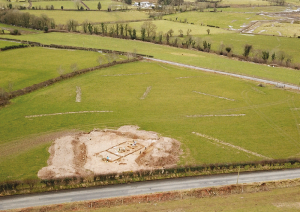Archaeological Discoveries are ‘Unearthed’
Date published:
A new publication entitled ‘Unearthed’ has been published which summarises some of the most significant archaeological discoveries in Northern Ireland between 2015 and 2018

In this period almost 800 licensed archaeological excavations took place, mainly as a requirement of the planning process. The publication was produced by the Department for Communities Historic Environment Division (HED).
HED Senior Archaeologist Andrew Gault said: “These excavations have resulted in exciting and important new information about our past, from evidence of the homesteads of some of the first prehistoric farming communities in Northern Ireland to more recent urban archaeological remains and industrial heritage. It is intended that ‘Unearthed’ will continue as a regular annual bulletin of the most significant archaeological discoveries arising from development-led archaeology in Northern Ireland.”
A substantial rectangular Neolithic house was identified at Turmeel townland, Co. Londonderry during the archaeological investigation of the A6 near Dungiven. It measured approximately 14m long and 7m wide and contained almost 1400 sherds of Neolithic pottery. This building was constructed during the period when farming and agriculture were introduced almost 6000 years ago.
At Glenshane Road, Claudy, a Late Neolithic ritual site was discovered during a quarry extension. This consisted of a timber circle – large wooden posts with an outer fenced forecourt – which dated to circa 2500 BC. Timber circles are likely to have been the focus of elaborate ritualised activities attended by large numbers of people.
A Bronze Age roundhouse was identified at Rasharkin solar farm. It consisted of a post-ring, an internal heath, areas of stakeholes, and a segmented enclosure. Enclosed houses generally date to the Middle Bronze Age, c. 1500 BC. Finds included a possible rubbing stone and several sherds of Late Bronze Age coarseware pottery.
An 18th/19th-century tannery was discovered within the centre of the site at Royal Exchange in Belfast. This site is located within what would have been the 17th-century core of the city, an urban industrial operation where leather would have been produced commercially. This was represented by a series of 15 tanning pits, the majority of which were constructed of wooden planks joined together by wooden dowels.
Andrew continued: “These new discoveries highlight the importance of archaeological mitigation in advance of development, as well as the significant contributions made by developers and archaeologists in unearthing these new archaeological sites for the benefit of all in society.”
Unearthed is available on the Department for Communities website.
Notes to editors:
- For updates on the Department for Communities follow us on Twitter - @CommunitiesNI
- For media enquiries or images please contact the DfC Press Office on 028 9082 3532. Out of office hours contact the duty press officer on 028 9037 8110.